
Zernike is a lunar impact crater that is located on the far side of the Moon.

Biela is a lunar impact crater that is located in the rugged highlands of the southeastern Moon. It is named after Austrian astronomer Wilhelm von Biela. The crater lies to the east of Rosenberger, to the southeast of the Watt–Steinheil double crater.
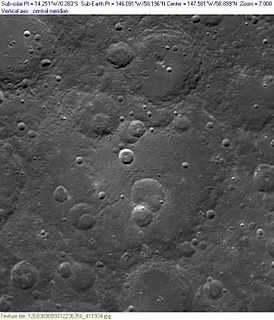
Birkhoff is a giant lunar walled plain that is located on the far side of the Moon, in the northern hemisphere. This formation is an ancient impact site that has been heavily eroded, and the surface reshaped by multiple craters in the interior and along the rim. The outer wall is bordered by the craters Carnot to the south, Rowland along the west rim, and Stebbins to the north. Just to the northeast is van't Hoff.
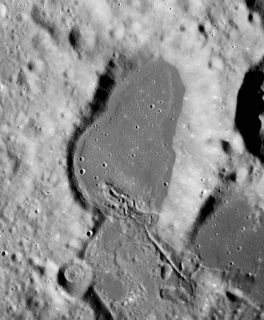
Bowditch is a lunar impact crater that lies on the far side of the Moon, just beyond the eastern limb. It is located on a region of the lunar surface that is brought into view due to libration, but at such times the area is viewed from the edge and so not much detail can be observed. It lies just to the north of the small Lacus Solitudinis lunar mare, between the craters Titius to the southwest and Perel'man to the east-northeast.

Desargues is an ancient lunar impact crater that is located near the northern limb of the Moon, on the western hemisphere. It lies nearly due south of the crater Pascal, and southeast of Brianchon. The proximity of this crater to the limb means that it appears highly elongated due to foreshortening, and it is difficult to discern details from the Earth.

Berzelius is a lunar impact crater located in the northeast part of the Moon's near side. It lies to the southeast of the crater Franklin, and to the northwest of Geminus.

Brunner is a lunar impact crater that is located along the eastern limb of the Moon, to the southeast of the Mare Smythii. At this location the crater is viewed from the edge, and so it is not possible to see much detail from the Earth. The visibility of this formation is also affected by libration. The crater lies to the southwest of the walled plain Hirayama, and to the east of the elongated crater Houtermans.
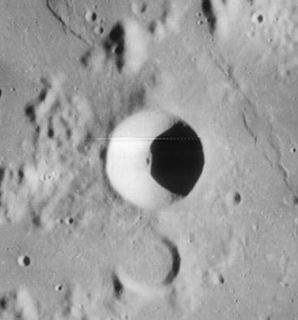
Darney is a small lunar impact crater that is located on the region of the Moon where the Mare Nubium joins the Oceanus Procellarum. It was named after French astronomer Maurice Darney. To the south is the lava-flooded crater Lubiniezky. The southern rim of Darney is attached to a series of low ridges that extend to the southwest.

Casatus is a lunar impact crater that is located near the southern limb of the Moon. The north-northeast rim of the crater overlies a portion of the slightly larger crater Klaproth. Along the western rim, Casatus A intrudes somewhat into the interior, producing an inward-bowing rim. To the southeast of Casatus is Newton.
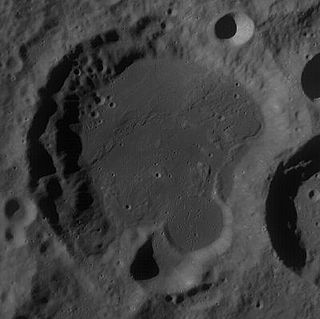
Crocco is a lunar impact crater that is located on the far side of the Moon from the Earth. It is located to the northeast of the huge walled plain Planck, and northwest of the equally huge Poincaré. Just to the north, within one crater diameter, is the crater Koch.

Campbell is a large lunar impact crater that is located in the northern hemisphere on the far side of the Moon. It lies to the southwest of the walled plain D'Alembert, an even larger formation. If Campbell were located on the near side of the Moon as seen from the Earth, it would form one of the largest visible craters, being slightly larger than Schickard. It is bordered by several craters of note, with Wiener to the southwest, Von Neumann just to the south, Ley overlying the southeast rim, and Pawsey to the west.

De Sitter is a lunar impact crater that is located near the northern limb of the Moon, to the north of the Baillaud–Euctemon crater pair. Due to its location, this crater appears very foreshortened when viewed from the Earth, limiting the detail that can be viewed. The crater also receives sunlight at a low angle, when it is on the sunlit side.

Chevallier is a lunar impact crater that is located in the northeastern part of the Moon's near side, about a crater diameter east-southeast of the prominent crater Atlas. To the south-southeast of Chevallier is the flooded crater Shuckburgh.
Cooper is a lunar impact crater that is located in the northern hemisphere on the far side of the Moon. It lies to the east of the large walled plain D'Alembert, and west-southwest of the crater Chappell.

Couder is a small lunar impact crater that is located just behind the western limb of the Moon, in a region of the surface that is brought into view during favorable librations. It lies on the inner foothills of the Montes Cordillera, a ring-shaped mountain range that surrounds the Mare Orientale impact basin.
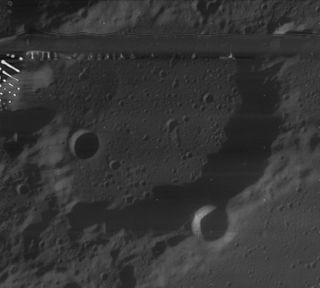
Euctemon is a lunar impact crater that is located in the northern part of the Moon, along the northwest rim of the crater Baillaud. To the southwest of Euctemon is the large walled plain Meton, and to the north-northeast lies the crater De Sitter. Due to its location, Euctemon appears foreshortened when viewed from the Earth.

Comrie is a lunar impact crater. It is located on the rugged far side of the Moon relative to the Earth, beyond the western limb. Nearby craters of note include Ohm to the south-southwest, Shternberg to the southwest, and Parenago to the northeast.

Ricco is a lunar impact crater. It is located in the northern part of the Moon's far side. This crater overlies the southeastern rim of the larger crater Milankovic. Less than one crater diameter to the southwest is Karpinskiy, while to the southeast is Roberts.
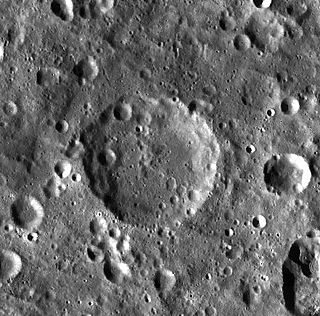
Freundlich is a lunar impact crater that is located on the far side of the Moon. It lies midway between the craters Trumpler to the north-northwest and the irregular Buys-Ballot to the south-southeast. This crater has a circular rim that is more heavily eroded at the northern and southern ends. Groups of craters lie across the floor to the southeast and the north, and individual small craters lie elsewhere within the interior. The crater is named after Erwin Freundlich.

Spencer Jones is a lunar impact crater on the Moon's far side. It is a roughly circular feature with a rim edge that is only moderately eroded. The inner wall of Spencer Jones is wider than elsewhere. The interior floor is relatively level with a low ridge offset to the south of the midpoint. Attached to the southwestern outer rim is the small satellite crater Spencer Jones Q.






















